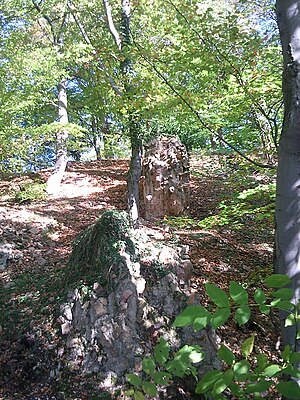Jossa Castle
| Jossa Castle | ||
|---|---|---|
|
Castle remains |
||
| Alternative name (s): | Tagesberg (1312), Dagesberg (1335), Dasperg (1339), Dagesbach (1356), Darsberg (1783) | |
| Creation time : | around 1290 to 1300 | |
| Castle type : | Höhenburg, summit location | |
| Conservation status: | Foundations, moats | |
| Standing position : | Free nobles | |
| Place: | Jugenheim and Alsbach | |
| Geographical location | 49 ° 44 '37.7 " N , 8 ° 38' 17.5" E | |
| Height: | 290 m above sea level NHN | |
|
|
||
The Castle Jossa , even Dagsberg called, is a now existing only in remnants ruins of a hilltop castle on 290 m above sea level. NHN between Jugenheim and Alsbach in the Darmstadt-Dieburg district .
history
The castle was built around 1290-1300 by the brothers Gebhard II and Giso IV von Jossa on the Dagsberg. They were the sons of Reinhard I von Jossa (named after the castle Joß in Burgjoss near Salmünster ) and his wife Agnes, a daughter of the noble lord Konrad II von Bickenbach (1245-1270) and his wife Guda von Falckenstein (1237-1287) , the widow of Schenk Konrad II von Klingenberg . After the deaths of Konrad (before 1272) and Guda (before 1290), Agnes and her sons Gebhard and Giso inherited the Jossa office, which consisted of Jugenheim, Balkhausen, Quaddelbach, Winthan, Staffel and the exclaves Langwaden and the Dietersklingen farm. The brothers built the castle, then called Jossa, on the approximately 295 m high and then called Dagsberg near Jugenheim.
Soon after, on August 4, 1312 Gerhard and Giso carried the castle the Mainz Archbishop Peter von Aspelt fief, and they received from him as a fief back, with the obligation to keep it open for the Archbishop. In the case of feuds , Giso had to behave neutrally and Gerhard to help the Mainz people.
Gerhard II died around 1335, and his heirs gradually sold the castle and the lands belonging to it to the Erbach taverns . Giso's widow Hedwig and her son also sold their shares in Erbach. With this, the entire Jossa office came into the sole possession of the Erbacher, although it was still a Mainz fief. After 1360 the castle fell into disrepair and was demolished over time for material extraction.
Excavation and subsequent use
In September 1848, Grand Duke Ludwig III. from Hessen-Darmstadt dig in the ruins, but not much was found: three storage pots, a horn, a shield, nails and a small sword. In 1860 the foundation walls that were exposed in 1848 were filled in. The raised hill was leveled and turned into a dance floor. Today hiking trails lead past the remains of the ramparts and the moat.
Equipment of the former castle
The castle was secured with a double rampart on the slope. The ramparts are still preserved. On a floor area of 25 m × 40 m, there was a residential and farm building to the west of the facility and a stable and the keep , which had a diameter of 8.4 m, to the east . The shield wall was up to 3.75 m thick. Apparently there was neither a well nor a cistern , and this deficiency probably explains the imminent abandonment of the facility. The castle had no kennel , but within the curtain wall there was another wall that reached from the keep into the courtyard, so that enemies could be stopped until the defenders had retreated into the tower.
literature
- Hans Buchmann, The castles and palaces on the Bergstrasse . Stuttgart 1989.
- Rudolf Knappe: Medieval castles in Hessen. 800 castles, castle ruins and fortifications. 3. Edition. Wartberg, Gudensberg-Gleichen 2000, ISBN 3-86134-228-6 , p. 521.
- Dieter Michael Feineis: The family tables of the gentlemen from Bickenbach. In: Würzburger Diözesangeschichtsblätter 62/63 (2001), pp. 1003-1019 ( PDF file; 558 kB ).
Web links
- Dagsberg Castle, Darmstadt-Dieburg district. Historical local lexicon for Hesse (as of February 17, 2014). In: Landesgeschichtliches Informationssystem Hessen (LAGIS). Hessian State Office for Historical Cultural Studies (HLGL), accessed on July 9, 2014 .
- Castle world: Jossa Castle






